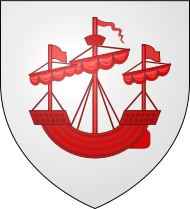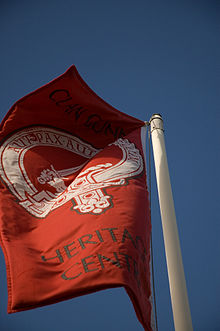Clan Gunn
| Clan Gunn | |||
|---|---|---|---|
| Na Guinnich[1] | |||
 | |||
| Motto | Aut pax aut bellum (Either peace or war)[2] | ||
| Profile | |||
| Region | Highlands | ||
| District | SutherlandandCaithness[2] | ||
| Plant badge | Juniper[2] | ||
| Pipe music | Failte na’n Guinnach(The Gunns' Salute)[2][3] | ||
| Chief | |||
 | |||
| Iain Alexander Gunnof that Ilk | |||
| The Gunn of Gunn | |||
| Historic seat | Gunn's Castle (Clyth Castle)[4] | ||
| |||
| |||
| |||
| |||
Clan Gunn(Scottish Gaelic:Na Guinnich) is aHighlandScottish clanassociated with lands in northeastern Scotland, includingCaithness,Sutherlandand, arguably, theOrkney Isles.Clan Gunn is one of the oldest Scottish Clans, being descended from the NorseJarls of Orkneyand thePictishMormaers of Caithness.
History[edit]
Origins[edit]
Traditional origins[edit]
The traditional origin of the Clan Gunn is that the progenitor of the clan was oneGunniwho came toCaithnessat the end of the 12th century when his wife, Ragnhild, inherited the estates from her brother,Harald Maddadssonwho was theEarl of Orkney.[8]His wife descended fromSt Ragnvald,who was the founder of theSt Magnus CathedralinKirkwall,Orkney.[8]Gunni,whose name meantwar,was allegedly descended fromVikingadventurers and his grandfather wasSweynwho was killed in a raid onDublinin 1171.[8]Smibert, however, states that the Gunns were ofGaelicorigin.[9]Further information on the Norse origins of Clan Gunn can be found in an article written by Michael James Gunn, quotingSir Robert Gordon'sA Genealogical History of The Earldom of Sutherlandfrom the 17th century: "Sir Robert Gordon, in researching genealogies for his work interviewed many of the heads of families in Sutherland, among them Alexander Gun of Kilearnan and Navidale, 4th Mackeamish, who died in 1655. From him he learned that Mackeamish’s familyare called Clan-Gun from one called Gun, whom they allege to have been the king of Denmarke his sone, and came many dayes agoe from Denmark, and settled himself in Catteynes.The significance of this statement is made clear when it is remembered that, in Sir Robert Gordon’s time, the kingdoms of Denmark and Norway were united under the Danish crown. However, the ancient Gaelicsennachiesdescribed the Gunns as Lochlannaich, or Norwegians, not Danes, because at the time of their forebear’s arrival in Orkney and Caithness, Norway was a separate kingdom and not united with Denmark until the Union of Kalmar in 1391.[10]
Recorded origins[edit]
The first 'chief' of the Clan Gunn to appear in historical records definitively was George Gunn, who was thecrounerorcoronerof Caithness during the 15th century.[8]The later Celtic patronymic of the Gunn chiefs may have beenMacSheumais Chataich,however 'George' Gunn was widely known asAm Braisdeach Morwhich means thegreat brooch-wearer.[8]This was due to the insignia that was worn by him as coroner.[8]George is said to have held court at his Clyth Castle in such splendor that it would rival any Highland chief.[8]
15th century and clan conflicts[edit]

TheBattle of Harpsdalewas fought in 1426 where the Clan Gunn fought an inconclusive battle with theClan Mackay.[11]
The Gunn's traditional enemies were theClan Keith,who from their Ackergill Castle, challenged the Gunn chiefs for both political needs and for land.[8]In one such feud it was claimed that Dugald Keith coveted Helen, daughter of Gunn of Braemor.[8]The girl resisted Keith's advances but on learning that she was to be married to another man, he surrounded her father's house, slew many of the inhabitants and carried the girl to Ackergill Castle where she threw herself from the tower, rather than submitting to her kidnapper.[8]The Gunns retaliated and repeatedly raided the Keith's territory; however, they suffered defeat in 1438 or 1464 at theBattle of Tannach.[8]Both sides having suffered considerable losses agreed to meet and settle their differences in what is known as theBattle of Champions,where each side was to bring twelve horses.[8]However, the Keiths arrived with two warriors on each horse and slaughtered the outnumbered Gunns.[8]This was in turn avenged by the chief's remaining son James who killed Keith of Ackergill and his son at Drummoy.[8]
16th century and clan conflicts[edit]
In 1517 the Clan Gunn supported theClan Sutherlandin defeating the Clan Mackay at theBattle of Torran Dubh.[12]
Alistair Gunn, son of John Robson Gunn, had become a man of much note and power in the North. He had married the daughter ofJohn Gordon, 11th Earl of Sutherlandand for this reason "he felt entitled to hold his head high amongst the best in Scotland". His pride, or perhaps his loyalty to the Earl of Sutherland, led to his undoing when in 1562, he led Gordon's retinue and encounteredJames Stewart, 1st Earl of Moray,and his followers on the High Street ofAberdeen.The Earl of Moray was the bastard half-brother ofMary, Queen of Scots,as well as the son-in-law ofWilliam Keith, 4th Earl Marischal,chief of Clan Keith. It was the custom at the time to yield thoroughfares to the personage of greater rank, and in refusing to yield the middle of the street to Stewart and his train, Alistair publicly insulted the Earl. Stewart soon afterward had him pursued to a place called Delvines, near Nairn. There he was captured byAndrew Munro of Milntownand taken to Inverness, and following a mock trial, he was executed.[13][14]
In the late 16th century the Gunns were involved in a number of feuds against theEarl of SutherlandandEarl of Caithness.[8]In 1586 at theBattle of Allt Camhnathe Clan Gunn was victorious but they were defeated shortly afterward by a massive force at theBattle of Leckmelm.[15]
17th century and Civil War[edit]
During the 17th century the Clan Gunn strengthened their links with theClan Mackaywhen Gunn of Kilearnan married Mary Mackay, sister ofLord Reay,chief of Clan Mackay.[8]The next Gunn chief married Lord Reay's daughter.[8]
Another branch of the clan, the Gunns of Bramore, who descend from Robert, a younger son ofAm Braisdeach Mor,were generally known as the Robson Gunns.[8]Sir William Gunn, brother of the Robson chief, despite being Catholic, served in the army of the Protestant king ofSweden,and rose to command a battalion.[8]He later fought forCharles Iand received a knighthood in 1639.[8]He later returned to the Continent where he served theHoly Roman Empireand married a German baroness.[8]He became an imperial general and was created baron of the Holy Roman Empire in 1649.[8]
18th century and Jacobite uprisings[edit]
The Gunns as a Clan did not support the Stuarts and fought for the British Government during theJacobite rising of 1745.[8]Alexander Gunn, chief of the Clan Gunn, was a Captain of anIndependent Highland Companythat fought for the British Government.[16]
Gunns did independently fight for the Bonnie Prince and a list can be found in the publication No Quarter Given, the muster roll of Prince Charles Edward Stuart's Army 1745–46.
Gunns were heavily drawn upon for the 79thQueen's Own Cameron Highlandersregiment during the French revolutionary and Napoleonic wars.[17]
Chieftainship[edit]

On 25 September 2015, the Lord Lyon King of Arms for Scotland issued an interlocutor recognizing Iain Alexander Gunn of Banniskirk as Chief of Clan Gunn. He is now Iain Alexander Gunnof that Ilk,Chief of Clan Gunn. At a Family Convention, held in Orkney on July 18, 2015, a petition to the Lyon Court requesting this recognition was approved and sent to the Lyon for action. For the first time in 230 years the Clan has a recognized Chief. Iain previously served as Commander of Clan Gunn for over forty-three years.[18]
Commanders[edit]
Iain Alexander Gunn of Banniskirk was appointed the secondCommanderof Clan Gunn, by commission ofLord Lyonon 9 June 1972.[19]He was Secretary of the Clan Gunn UK Society on its establishment in 1961. The first Commander was his paternal uncle, William Gunn of Banniskirk, who held the title from 1967 to 1968.
In 1978, the previous Chief of Clan Keith and the then Commander of Clan Gunn signed a peace treaty at the site of theChapel of St. Tayrs,ending the feud between the two clans which began in 1478.[20]
Castles[edit]

- Gunn's Castle also known as Clyth Castle was situated on a rock above the sea, eight miles south-west ofWick,Caithness.[4]It was once a splendid and strong castle but virtually nothing remains.[4]The fortress was held by the Gunns during their feud with theClan Keith.[4]
- Dirlot Castle nearWatten,Caithness was originally held by the Cheynes but passed to the Gunns in the 15th century.[4]However, later it went to the Clan Sutherland and then the Clan Mackay.[4]
- Halberry Castle near Wick, Caithness was held by the Gunns but there are now only some remains by the sea.[4]
- Latheron Castle nearDunbeath,Caithness, was held by the Gunns but passed to the Clan Sinclair in the 17th century and there are only slight remains left of the castle.[4]Latheron House dates from the 18th century.[4]
- Kinbrace, site of castle once held by the Gunns, although the location is not certain.[4]
Tartan[edit]
The Gunn tartan is found in 'weathered', 'ancient', 'muted', and 'modern' colourings. A picture of the Tartan[1]
Notes[edit]
- ^Most of the Clan Gunn sept names are derived from the names of chief's sons: Johnson, MacIan, Mackean, Kean and Keene all derive from 'son of John'. Further to this James, John, Henry, Rob and Will were all sons of the same chief George Gunn of the 14th century.[6]
- ^The Clan Gunn Society Membership list gives no less than 77 names "recognised as being associated with Clan Gunn" but the list given in Frank Adam's "The Clans, Septs and Regiments of the Scottish Highlands". Revised by Sir Thomas lnnes of Learney is much shorter. This is the list the Chief and Council recognise
References[edit]
- ^Mac an Tàilleir, Iain."Ainmean Pearsanta"(docx).Sabhal Mòr Ostaig.Retrieved15 October2009.
- ^abcd"Clan Gunn Profile".scotclans.Retrieved22 January2014.
- ^"The Gunn's Salute (Sheet music)"(PDF).pipesdrums.Retrieved5 January2021.
- ^abcdefghijCoventry, Martin (2008).Castles of the Clans: The Strongholds and Seats of 750 Scottish Families and Clans.Musselburgh:Goblinshead. p. 248.ISBN978-1-899874-36-1.
- ^"Membership".clangunnsociety.org.Retrieved22 September2019.
- ^Scots Kith & Kin.HarperCollins.2014. p. 62.ISBN9780007551798.
- ^abcdGunn, Robert (2002)."The Septs of Clan Gunn - which belong?".skyelander.orgfree.Retrieved5 January2021.
Quoting: Gunn, Mark Rugg (1969). 'History of the Clan Gunn'. p. 268
- ^abcdefghijklmnopqrstuvwWay, George of Plean;Squire, Romilly of Rubislaw(1994).Collins Scottish Clan & Family Encyclopedia.Glasgow:HarperCollins(for theStanding Council of Scottish Chiefs). pp. 399–400.ISBN0-00-470547-5.
- ^Smibert, Thomas. (MDCCCL). (1850).The Clans of the Highlands of Scotland, being an Account of their Annals, Separately & Collectively, with Delineations of their Tartans, and Family Arms.pp. 170–171.
- ^Gunn, Michael James. (2001).Olaf the Black and the Clan Gunn
- ^Gordon, Sir Robert(1580–1656),A Genealogical History of the Earldom of Sutherland.pp. 63–64.
- ^Sinclair, Thomas. (1890).The Gunns.p. 36.
- ^"Clan Gunn history".electricscotland.Retrieved25 February2014.
- ^Gordon, Robert(1813) [Printed from original manuscript 1580 - 1656].A Genealogical History of the Earldom of Sutherland.Edinburgh: Printed by George Ramsay and Co. for Archibald Constable and Company Edinburgh; and White, Cochrance and Co. London. p. 144.
- ^Gordon, Sir Robert. (1580–1656).A Genealogical History of the Earldom of Sutherland.p. 183.
- ^Simpson, Peter (1996).The Independent Highland Companies, 1603 - 1760.Edinburgh:John Donald Publishers.pp. 214–215.ISBN0-85976-432-X.
- ^Mackenzie, Thomas Arthur; Ewart, John Spencer; Jameson, Robert (1887).Historical Records of the 79th Queen's Own Cameron Highlanders.London: Hamilton, Adams. p.8.Retrieved4 March2021.
- ^Clan Gunn appoint new chief after 230 yearsArchived21 April 2016 at theWayback Machinedailyrecord.co.uk. Retrieved April 25, 2016.
- ^Chiefship of Clan GunnArchived8 July 2007 at theWayback MachineClan Gunn Society.
- ^"History of the Keith Family".ceiteach.org.nz.Archived fromthe originalon 13 January 2020.Retrieved5 January2021.
External links[edit]
- Clan Gunn Society UK
- Clan Gunn Society of North America
- Clan Gunn Society of North America – Eastern Canada Branch
- Gunn DNA Project
- The Clearance village of Badbea; by a Gunn descendant
- Gunn @ ElectricScotland
- [2]Lord Lyon on the Family Convention rejection
- [3]Lord Lyon on a Gunn Chief issue.
- Gunns of Auckingill (Australian Gunn website)
